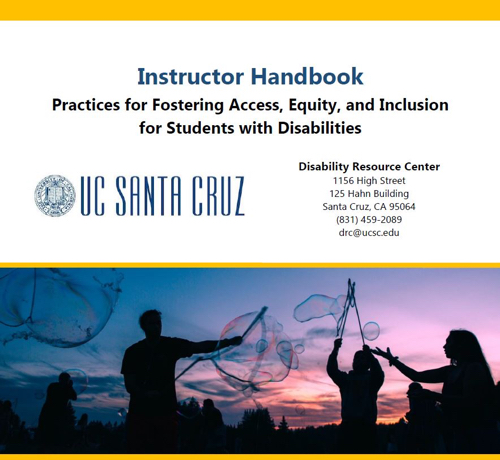Campus News
New handbook represents campus’s collaborative approach to supporting students with disabilities
As a campus dedicated to ensuring that all students have an equal opportunity to succeed and thrive academically, UCSC has a responsibility as well as a commitment to provide full access to academic courses and programs to students with disabilities.


This month, the UCSC Disability Resource Center (DRC) is making available an instructor handbook entitled, “Practices for Fostering Access, Equity, and Inclusion for Students with Disabilities.” A collaborative endeavor between the Division of Student Success and the Center for Innovations in Teaching and Learning (CITL), the handbook was compiled in response to feedback over the past few years about the need for a comprehensive, practical guide to better support classroom instructors–including faculty, GSIs, and TAs–in serving students with disabilities at UCSC.
As a campus dedicated to ensuring that all students have an equal opportunity to succeed and thrive academically, UCSC has a responsibility as well as a commitment to provide full access to academic courses and programs to students with disabilities. Yet as the number of students registering for accommodations has risen, instructors have repeatedly asked for practical, hands-on advice about how best to give access to students with disabilities, as well as how to balance individual accommodations with class requirements and expectations. This handbook is an important step towards providing such practical, instructor-facing information.
The handbook reviews the legal basis and history of disability rights to contextualize “why” we do this work and to understand the evolving landscape of equal opportunity. It also outlines the shared responsibilities of students, instructors, and the institution in the accommodations process (i.e., the “how”). Functional explanations provide instructors a guided review of the specific expectations of the instructor role. The handbook also discusses inclusive pedagogy with a focus on universal design, an approach to course design that cuts down on the need for accommodations by “building in” inclusive elements. Universal Design techniques include captioning video and web audio and making sure all documents and web pages are accessible and can be converted to alternative formats. The handbook also includes practical strategies for promoting inclusive learning practices in the classroom. The final section of the handbook outlines pedagogical approaches to support students with specific disabilities, suggests reasonable accommodations, gives information about where to go for additional information, and shares resources so instructors can “go deeper” into topical areas to increase understanding of what it means to ensure equal access to particular populations of students with disabilities.
This handbook has been developed as a resource to support educators and to support the meaningful impact instructors have on students every day. It represents the results of a collaborative approach to serving students with disabilities that has emerged on the campus over the past couple of years as the DRC and CITL have worked closely to come up with better resources for faculty and other instructors. Instructors frequently report feeling inadequately prepared to discern what constitutes appropriate accommodations with relation to attendance, deadlines, examinations, and other aspects of course design and teaching practice that may need to be modified for students with disabilities. It is our sincere hope that this handbook will begin to demystify aspects of the accommodations process and help instructors understand both their rights and their responsibilities with relation to students with disabilities.
Both the DRC and the CITL welcome feedback regarding the handbook, and are planning a revision in summer 2019 in response to community comments on the first edition. A Google form has been set up to collect feedback. You can access the form here.